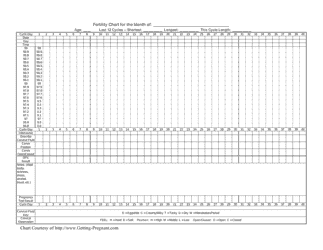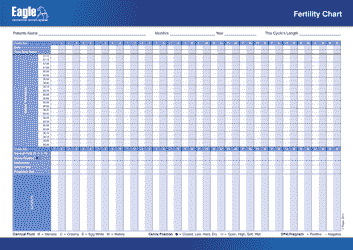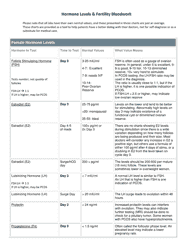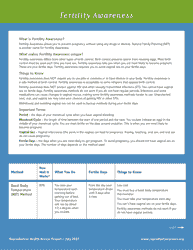Fertility Chart
A fertility chart is used to track a woman's menstrual cycle, with the goal of determining when ovulation occurs. It's an essential tool for couples trying to conceive as it helps identify the most fertile days in a woman's cycle. This chart includes tracking of various elements such as body temperature (Basal Body Temperature), changes in cervical mucus, menstrual cycle dates, and other symptoms related to fertility. It aids in providing insights about hormonal changes, irregularities, potential conception dates and even early signs of pregnancy in a woman’s cycle. It can also be beneficial for those using natural methods for contraception.
A fertility chart is typically filed by a woman or a couple who are trying to conceive. This chart tracks the woman's bodily changes throughout her menstrual cycle, including basal body temperature and cervical mucus, to help identify the most fertile times of the month. In some cases, a healthcare professional or fertility specialist may assist in creating and interpreting fertility charts.
FAQ
Q: What is a fertility chart?
A: A fertility chart is a method that women use to track their menstrual cycles, ovulation and fertility symptoms. It can assist in family planning as well as diagnosing potential reproductive system issues.
Q: How to use a fertility chart?
A: To use a fertility chart, one needs to record daily body temperature, changes in cervical mucus, days of the menstrual cycle, and any other symptoms. Over time, these charts provide a pattern that can predict when ovulation may occur.
Q: Why would someone use a fertility chart?
A: People use fertility charts to better understand their reproductive cycle for various reasons, including trying to conceive, trying to avoid pregnancy naturally, or identifying potential fertility issues.
Q: Can a fertility chart help to determine the best time to conceive?
A: Yes, fertility charts can help predict the most fertile days in a woman's menstrual cycle, providing a higher chance for successful conception.
Q: Are fertility charts accurate?
A: While fertility charts can provide a good estimate of ovulation and fertility times, they are not 100% accurate. There are many factors that can affect a woman's cycle, including stress, illness, and lifestyle changes.
Q: Who can benefit from a fertility chart?
A: Any woman who wishes to gain a better understanding of her reproductive cycle can benefit from using a fertility chart. It is especially beneficial for those trying to conceive or practicing natural family planning methods.
Q: What's the role of basal body temperature in a fertility chart?
A: Basal body temperature (BBT) is your body's temperature at rest. A slight increase in BBT can indicate ovulation. By tracking this over several cycles, patterns can emerge to help predict future ovulation times.






